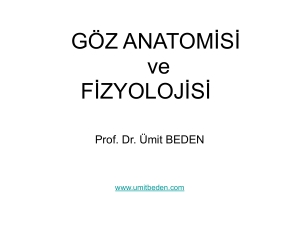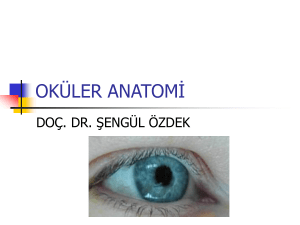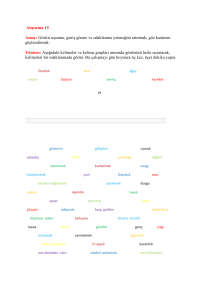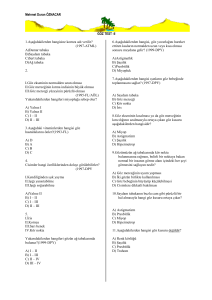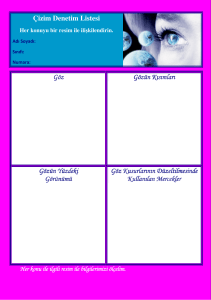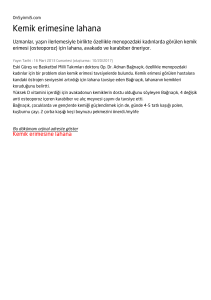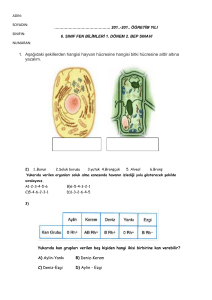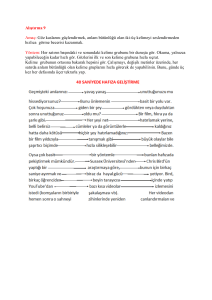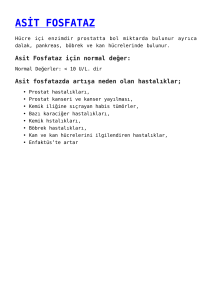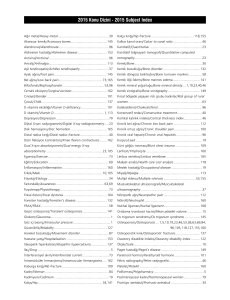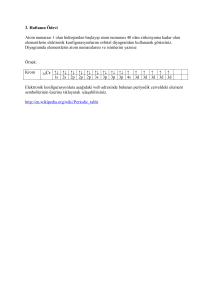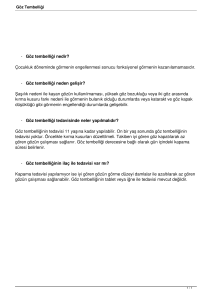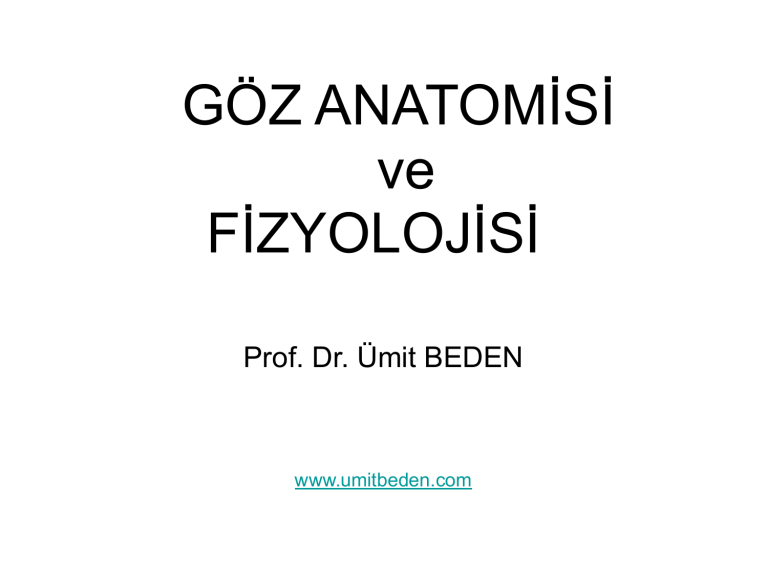
GÖZ ANATOMİSİ
ve
FİZYOLOJİSİ
Prof. Dr. Ümit BEDEN
www.umitbeden.com
» Orbita
» Kas sistemi
» Sinir sistemi
» Damarsal sistem
» Lakrimal sistem
» Kornea ve Sklera
» Lens
» Optik ve refraksiyon
» Akomodasyon
» Aköz Humor
» Vitreus
2
» Üveal doku
» Retina
» Görsel algılama
» Görme keskinliği
» Binoküler görme
» Görme gelişimi
» Görme testleri
» Renkli görme
» Görsel adaptasyon
» Optik sinir
» Santral görme yolları
3
Anatomik terimler
» Anatomik terimler
» Medial: Orta hatta yakın
» Lateral: Orta hattan uzak
» Superior: Yukarıda
» Inferior: Aşağıda
» Anterior: Önde
» Posterior: Arkada
» Dextro: Sağ
» Levo: Sol
4
y
z
x
5
superior
posterior
z
y
lateral
medial
levo
x
dextro
aksiyel düzlem (x-z)
anterior
inferior
6
7
Sagital düzlem (y-z)
y
z
x
8
9
10
y
z
x
koronal düzlem (x-y)
11
12
y
posterior
z
lateral
levox
medial
b
dextro
a
aksiyel düzlem (x-z)
anterior
13
Sagital düzlem (y-z)
superior
b
posterior
z
a
x
anterior
inferior
14
superior
y
z
a
b
y
levo
x
x
lateral
dextro
medial
inferior
koronal düzlem (x-y)
15
16
Orbita
• KEMİKLER
• AKSESUAR
YAPILAR
• KASLAR
• DAMARSİNİRLER
• GÖZ KÜRESİ
Orbita
» Göz küresinin içinde bulunduğu kemik
çukur
» Yedi adet kafa kemiğinin birleşmesi ile
oluşur
Frontal kemik
Zigomatik kemik
Maksiller kemik
Lakrimal kemik
Etmoid kemik
Palatin Kemik
Sfenoid kemik
18
ORBİTA
ORBİTA
21
22
23
24
25
26
27
28
29
30
31
32
33
34
ORBİTA
ORBİTA
Orbİtal kemİkler
Frontal kemİk
zİgomatİk
kemİk
orbİtal
rİm
maksİllakemİk
Frontal
etmoİd kemİk
zİgomatİk
lakrİmal
maksİlla
sfenoİd
palatİn
AKSESUAR YAPILAR
Glob
Ekstraoküler adaleler
Damarlar
Sinirler
Orbital septum, periorbita
Lakrimal bez
Yardımcı bezler
Meibomian
Goblet hücreleri
Wolfring
Krause
Moll
Zeiss
Konjonktiva
Lockwood ligamanı (hamak)
Whitnall ligamanı (askı)
Troklea
ORBİTAL SEPTUM
whitnall ligamani
whitnall ligamani
lockwood ligamani
ey.
nd
he
FIGURE 10. Frontal view of major orbital connective tissues. Globe is
depicted as sectioned at approximately the coronal plane level of the
pulley rings, but the illustration also includes the more anteriorly
located medial and lateral entheses. LG, lacrimal gland; SOT, superior
oblique tendon.
Intercouplings between adjacent pulleys were also stereotypic in configuration and composition (Fig. 10). The MR–IR
band was not only the thickest such intercoupling, but it also
contained the most collagen, elastin, and SM. These features of
the MR–IR band seem ideal to provide a stiff elastic coupling
between the highly stable MR and relatively mobile IR pulleys,20 permitting the latter to move nasally and laterally, not
only under passive tension but also nasally during contraction
of the intrinsic band of small SM cells. This may be one
mechanism underlying nasal repositioning of the IR pulley
during convergence.31,32 In rat, a species without convergence, the MR–IR band is poorly developed and contains minimal SM.43 The MR–IR band forms part of the Lockwood
ligament, a structure that has been described to form a kind of
suspensory sling running mediolaterally inferior to the globe.38
However, the present study indicates that the connective tis-
at the zygomatic tubercle. The absence of direct enthesis of the
position for e
vertical rectus pulleys to the bone of the adjacent orbital rim
32
regions is a necessary consequence of the positions.
mobility of the L
superior and inferior eyelids, which move through these reDonders’
law
gions within only loose connective tissues. The
vertical rectus
pulleys are thus indirectly coupled to the medial
and lateralfro
be reached
entheses by the intercouplings between the rectus pulleys.
that
all such
Further stability is provided by the SO tendon
emerging
from p
its rigid trochlea and by the sheath and belly of
the IO muscle,
Listing’s
law
which originates from anterior orbital bone.
rotatio
Past descriptions suggested correctly thatocular
the orbital
connective tissue system supports and protects the globe, but such33
orientation.
descriptions emphasized a major role for the “check ligaments”
in limiting and dampening ocular movements.38 TheBefore
elasticity pu
of the check ligaments was believed to be important in gradtosmooth
be implem
uating the action of EOM contraction to ensure
ocular
rotations without jolting the globe.38 The active-pulley
hypoththe EOMs. Ho
esis,22,32 as well as the current quantitative anatomic findings,
for L
support quite a different interpretation of substrate
the check ligaments— elastic suspensions of the pulley system
actively
are that
encoded
regulates the direction of EOM force to control ocular kinematrate ofthechange
ics. In view of the misleading functional connotation,
term
check ligament should probably be abandoned.
tion of the th
The current report also makes a novel distinction between
15,35
the LLA and the LR–SR band. The LLA, connecting
the lateral E
stream.
expansion of the LPS to the anterior bony orbit while partially
traversing the lacrimal gland, appears to be stitial
mainly a nucleus
suspension for the LPS in relationship to the Whitnall
ligament.
The
burst
comman
LLA would only indirectly stabilize the SR pulley by mechanical
eye
positi
coupling of the LPS and SR. The lateral half of 3-D
the LLA
contains
abundant SM, whereas the medial half contains
striated
muscle
less,
Listing’s
contiguous with the LPS. In contrast, the LR–SR band extends
it isonlysystema
directly between the involved pulleys and contains
a small
37
amount of SM in small bundles. The LR–SR band is equivalent
(VOR) and
to the MR–SR band in thickness and collagen content, but
probably has lower stiffness, because the elastin
content ofreflex
the
ancient
LR–SR band is about one fourth of the MR–SR band. Elastin has
the property of reversible extensibility44 that retina
probablyduring
confers h
elastic stiffness on pulley suspensory tissues. ocular rotatio
The orbital aspect of each rectus pulley had more and
AKSESUAR YAPILAR
lakrimal bez
duktullar
lokalizasyon
patolojiler
septasyon
AKSESUAR YAPILAR
AKSESUAR YAPILAR
AKSESUAR YAPILAR
YÜZ KASLARI
• GÖZ KAPAĞINI ORBİKÜLARİS OCULİ KAPATIR
YÜZ KASLARI
• YÜZDEKİ DİĞER KASLARINI KONTROL EDEN
FASİYEL SİNİR TARAFINDAN KONTROL
EDİLİR
EKSTRAOKÜLER ADELELER
• GÖZ HAREKETLERİNİ KONTROL EDERLER
EKSTRAOKÜLER ADELELER
• GÖZÜ HAREKET ETTİREN 6 KAS VARDIR
EKSTRAOKÜLER ADELELER
• 3, 4 VE 6. KAFA SİNİRLERİ TARAFINDAN KONTROL
EDİLİRLER
EKSTRAOKÜLER ADELELER
• İKİ HORİZONTAL İKİ VERTİKAL İKİDE OBLİK
KAS VARDIR
EKSTRAOKÜLER ADELELER
• KASLARIN HER BİRİNİN ASIL GÖREVİ FARKLIDIR
EKSTRAOKÜLER ADELELER
• FAKAT KASLARIN BİRDEN ÇOK GÖREVLERİ
VARDIR. GÖZÜN POZİSYONUNA GÖRE ETKİLERİ
DEĞİŞİR
EKSTRAOKÜLER ADELELER
• ALT OBLİK DIŞINDA KASLARIN HEPSİ ORBİTA
TEPESİNDEN KÖKEN ALIR
orbital İçerİk
EKSTRAOKÜLER ADELELER
• GÖZÜN ÇEVRESİNİ
SARARAK ÖNE
DOĞRU UZANIRLAR
• SIKLERAYA
YAPIŞIRLAR
EKSTRAOKÜLER ADELELER
• İKİ GÖZ BİRBİRİ İLE KOORDİNE OLARAK
HAREKET EDER
EKSTRAOKÜLER ADELELER
• KOORDİNASYONUN BOZULMASI ŞAŞILIĞA
NEDEN OLUR
Göz hareketleri
• Duksiyon: tek gözün hareketi
– Adduksiyon-içe bakış
– Abduksiyon-dışa bakış
• Versiyon: iki gözün aynı yöne hareketi
– Levoversiyon –sola bakış
– Dextroversiyon-sağa bakış
• Verjans: iki gözün ters yöne hareketi
– Konverjans-her iki gözün içe bakması
– Diverjans-her iki gözün dışa bakması
DAMARLAR VE SİNİRLER
• SİNİRLER OMURİLİK YERİNE DİREKT
BEYİNDEN KÖKEN ALIR
Oftalmik arter
Internal carotis arterin
ilk dalı
77
Oftalmik arter
•İnternal carotis (1)
•Oftalmik arter (2)
•Santral retinal (3)
•Lakrimal (4)
•Nazosiliyer (2)
•Posterior siliyer (8-9)
•Post etmoid (11)
•Ant etmoid (12)
•Medial palpebral (13)
•Supratroklear (15)
•İnfratroklear (14)
•Supraorbital (10)
Orbitada lenfatik bulunmaz
GÖZ KÜRESİ
• GÖZ KÜRESİ İÇ İÇE
GEÇMİŞ ÜÇ
TABAKADAN OLUŞUR
• FİBRÖZ TABAKA
• DAMARSAL TABAKA
• SİNİR TABAKA
FİBRÖZ TABAKA
• ÖNDE KORNEA,
ARKADA
SIKLERADAN
OLUŞUR
• KORNEA
SAYDAMDIR IŞIĞI
GEÇİRİR
• SIKLERA OPAKTIR
IŞIĞI GEÇİRMEZ
FİBRÖZ TABAKA
• SKLERA BEYAZDIR GÖZ KÜRESİNİN
ŞEKLİNİ VEREN DOKUDUR
• ARKADA OPTİK SİNİRİN ÇIKTIĞI OPTİK
KANALI VARDIR
FİBRÖZ TABAKA
• SKLERA EKSTRAOKÜLER ADELELERİN
GÖZE YAPIŞTIĞI YERDİR
FİBRÖZ TABAKA
• KORNEA GÖZ KÜRESİNİN IŞIĞI KIRAN
EN ÖNDEKİ SAYDAM TABAKASIDIR
FİBRÖZ TABAKA
• KORNEA SAYDAMLIĞI İÇERDİĞİ
LİFLERİN PARALELLİĞİNE VE SU
İÇERİĞİNDEKİ HASSAS DENGELERE
BAĞLIDIR. AYRICA İÇERİSİNDE DAMAR
VE SİNİR OLMAMASI GEÇİRGENLİĞİ
AÇISINDAN ÖNEMLİDİR.
• KORNEA BESLENMESİNİ GÖZYAŞI VE
HÜMÖR AKÖZDEN SAĞLAR
FİBRÖZ TABAKA
• KORNEA VE
SKLERANIN
BİRLEŞTİĞİ YER
LİMBUS’tur
• LİMBUS KORNEAYI
360 DERECE
ÇEVRELER
• LİMBUS SKLERANIN
ÖN SINIRI
KORNEANIN İSE
ARKA SINIRIDIR
DAMARSAL TABAKA
• UVEA ÜÇ KISIMDAN OLUŞUR
DAMARSAL TABAKA
• İRİS ÖNDEKİ KISIMDIR
• GÖZÜN RENGİNİ VEREN TABAKADIR
DAMARSAL TABAKA
• PUPİLLA BİR HİÇTİR (2-6 mm)
• İRİSİN ORTASINDAKİ BOŞLUKTUR
DAMARSAL TABAKA
• HER İKİ GÖZÜN PUPİLLASI EŞİT
OLMALIDIR
• PUPİLLA BÜYÜKLÜĞÜ İKİ TİP KAS
TARAFINDAN KONTROL EDİLİR
DAMARSAL TABAKA
• DAMARSAL
TABAKANIN İKİNCİ
KISMI SİLİYER
CİSİMDİR
– AKOMODASYONU
SAĞLAR
– HÜMÖR AKÖZ
ÜRETİMİNİ SAĞLAR
DAMARSAL TABAKA
• EN ARKADAKİ
KISIM
KOROİDEADIR
• RETİNANIN DIŞ
TABAKALARININ
BESLENMESİNİ
SAĞLAR
• BOL PİGMENTLİ
DAMARSAL AĞDAN
OLUŞUR
RETİNA
• GÖRSEL ALGILAMANIN OLDUĞU VE SİNİR
HÜCRELERİNİN BULUNDUĞU EN İÇ
TABAKADIR
• ÖNDE PARS PLANANIN BAŞLADIĞI YERE
KADAR UZANIR
RETİNA
GÖZ KÜRESİ
• GÖZ KÜRESİNİN İÇİNDE 3 BOŞLUK BULUNUR
– ÖNKAMARA
– ARKA KAMARA
– VİTREUS BOŞLUĞU
• LENS
– ARKA KAMARA İLE
VİTREUS ARASINDA
BULUNUR
GÖRME
Oftalmolojik alt branşlar
•
Konjonktiva-Kornea
•
Retina-Uvea
•
Nörooftalmoloji
•
Şaşılık
•
Okuloplastik cerrahi
•
Kırma kusurları
•
Glokom
•
Katarakt

